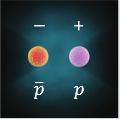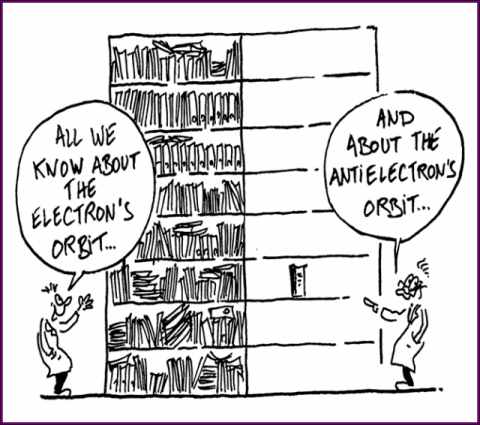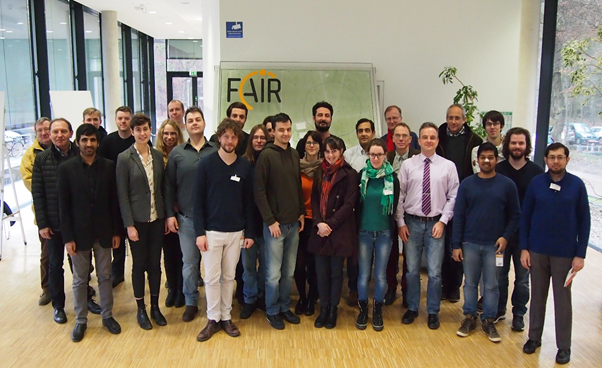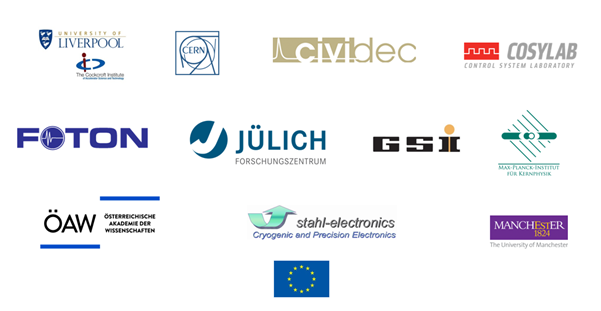The Accelerator Validating Antimatter Physics (AVA) Project
What is Antimatter?
Disclosure: Antimatter has nothing to do with dark matter!

Figure 1: Particle and Antiparticle
Antiparticles are mirror-images of particles with nearly the same properties, except for an opposite electric charge and some other quantum numbers, e.g. the positron is the ‘anti-electron’. When a particle and its antiparticle meet, they annihilate into pure energy.
The existence of antiparticles was first theoretically predicted by Paul Dirac in 1928 when he described the behavior of electrons moving near the speed of light. The first antiparticles (positrons) were observed 4 years later and we had to wait until 1955 for antiprotons. Later, we discovered that antiparticles are actually quite commonly created in high-energy natural events such as thunderstorms or radioactive decay.
Why is Antimatter Such a Hot Physics Topic?
You’ve probably noticed; we live in a universe of matter. However, we know that during the Big Bang, an equal amount of matter and antimatter were created. Somehow, about 1 in a billion particles of antimatter ‘survived’ and we still don’t understand why — so far, there have been no signs of a faraway ‘anti-universe’!
Obviously, we are missing something….
Current State of Antimatter Research

Figure 2: A promising research field
Researchers are tackling the question of antimatter by measuring and comparing properties of antiparticles to their matter equivalent.
CERN is at the epicenter of the research community thanks to the AD (Antiproton Decelerator) facility and the ELENA (Extra-Low ENergy Antiproton) project and will be backed by FLAIR (Facility for Low-energy Antiproton and Heavy-Ion Research) at GSI.
ELENA manages to cool the antiparticles down to 100 keV, feeding the different experiments. The main focus is currently on the effect of gravity on antimatter (GBAR and AEGIS), antihydrogen (ALPHA and ATRAP), fundamental symmetries (ASACUSA) and magnetic moments (BASE).
The current technologies used to create antiprotons in the AD, trap them and for their storage are very inefficient. More than 99% of the antiparticles are lost, so there is room for improvement and that’s where the AVA project finds its place.
What is AVA?
The AVA project focuses on research but also emphasizes outreach and training for fellows. As partners come from industry, universities and research centers working on particle accelerators, the mentors on the AVA project have a wide range of expertise.
The AVA project groups fifteen fellows organized around three work packages tackling the current limitations of antimatter research:
- design and optimization where the focus is on improving a key part of the accelerator, e.g. the electron gun or control system
- beam diagnostics where the focus is on detectors to measure the beam profile, position and/or intensity
- antimatter experiments to design experiments or improve existing experiments to measure the properties of antiparticles.

Figure 3: AVA fellows, and invited speakers at the second AVA workshop in GSI
Life as an AVA Fellow
Participating in the 1st package, the main objective for me as a Cosylab fellow is to collaborate with other fellows to integrate their projects into a control system. Without previous knowledge of this specific topic, I started to learn about control system technologies by completing the EPICS internal training. Guided by a Cosylab mentor, I built up my expertise by working on various projects, from designing and developing a demonstration stand of a personnel protection system using a PLC and EPICS, to improving the API of an FPGA board.
In addition, the AVA project places great emphasis on scientific outreach to raise public awareness. In partnership with the Institut Image where I did my Masters on virtual reality in 2017, we developed a prototype application to explore a particle accelerator in virtual reality.
Fellows are currently getting ready for the 2nd AVA school and symposium happening in June 2019 in Liverpool by preparing outreach demonstrations and posters explaining our work.
Even though AVA fellows are spread out across Europe collaboration is highly encouraged. We meet every three months for workshops and training schools, where researchers and people from the industry are also invited to share and discuss their work. Cosylab will be hosting the third AVA workshop on human-machine interaction in October 2019.
Dig Deeper
AVA: https://www.liverpool.ac.uk/ava/

The AVA Partners
Antimatter:
- 1st AVA school on low energy antimatter physics https://indico.cern.ch/event/677170/timetable/#20180625
- Wiki page https://en.wikipedia.org/wiki/Antimatter
CERN experiments: https://home.cern/science/experiments
About the Author
Adélaïde Grimaud joined Cosylab September 2018 to work on the development of a versatile control system for the AVA project. She obtained a double Master of Mechanical engineering and Digital engineering — interactive 3D technologies in 2017 at Arts et Métiers, France. After finishing her Master Thesis on exploration and annotation of data in virtual reality at the Brigham and Women Hospital in Boston, USA, she extended her stay in the laboratory to work on the development of SPINE, a medical research web platform.
